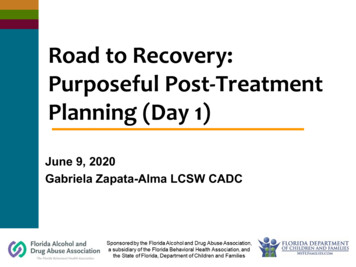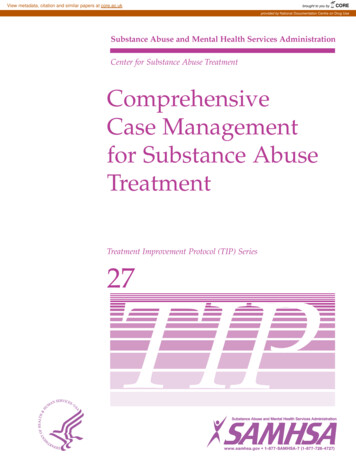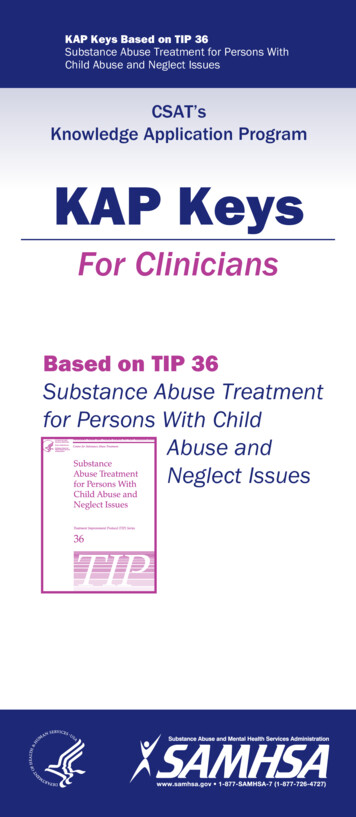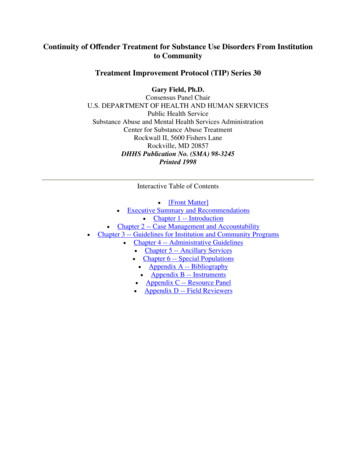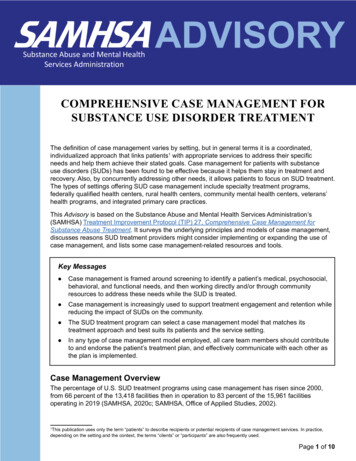
Transcription
Substance Abuse and Mental HealthServices AdministrationADVISORYCOMPREHENSIVE CASE MANAGEMENT FORSUBSTANCE USE DISORDER TREATMENTThe definition of case management varies by setting, but in general terms it is a coordinated,individualized approach that links patients1 with appropriate services to address their specificneeds and help them achieve their stated goals. Case management for patients with substanceuse disorders (SUDs) has been found to be effective because it helps them stay in treatment andrecovery. Also, by concurrently addressing other needs, it allows patients to focus on SUD treatment.The types of settings offering SUD case management include specialty treatment programs,federally qualified health centers, rural health centers, community mental health centers, veterans’health programs, and integrated primary care practices.This Advisory is based on the Substance Abuse and Mental Health Services Administration’s(SAMHSA) Treatment Improvement Protocol (TIP) 27, Comprehensive Case Management forSubstance Abuse Treatment. It surveys the underlying principles and models of case management,discusses reasons SUD treatment providers might consider implementing or expanding the use ofcase management, and lists some case management-related resources and tools.Key Messages Case management is framed around screening to identify a patient’s medical, psychosocial,behavioral, and functional needs, and then working directly and/or through communityresources to address these needs while the SUD is treated. Case management is increasingly used to support treatment engagement and retention whilereducing the impact of SUDs on the community. The SUD treatment program can select a case management model that matches itstreatment approach and best suits its patients and the service setting. In any type of case management model employed, all care team members should contributeto and endorse the patient’s treatment plan, and effectively communicate with each other asthe plan is implemented.Case Management OverviewThe percentage of U.S. SUD treatment programs using case management has risen since 2000,from 66 percent of the 13,418 facilities then in operation to 83 percent of the 15,961 facilitiesoperating in 2019 (SAMHSA, 2020c; SAMHSA, Office of Applied Studies, 2002).This publication uses only the term “patients” to describe recipients or potential recipients of case management services. In practice,depending on the setting and the context, the terms “clients” or “participants” are also frequently used.1Page 1 of 10
ADVISORYDefinitive statements about the overall effectiveness of case management cannot be made, becausestudies vary in their definitions of the term, methodology, study populations, intervention designs, andoutcome measures. However, multiple analyses (Joo & Huber, 2015; Kirk et al., 2013; Penzenstadler etal., 2017; Rapp et al., 2014; Regis et al., 2020) have found positive outcomes for one or more measures,such as treatment adherence, overall functioning, costs, decreases in substance use, reductions in acutecare episodes, and increased engagement in nonacute services. A 2019 meta-analysis comparing casemanagement with treatment as usual showed a small yet statistically significant positive effect, which wasgreater for treatment-related tasks than for personal functioning outcomes such as improved health statusand family relations and reductions in substance use and legal involvement (Vanderplasschen et al., 2019).Principles of case managementIt offers the patient a single point of contact with the health and social services system. The casemanager assumes responsibility for coordinating the care of patients who receive services from multipleagencies. This replaces a haphazard process of referrals with a single, more well structured service.It is patient centered. Each patient’s right to self-determination is emphasized. The case manager is familiarwith the patient’s experiences and world, and uses this understanding to identify psychosocial stressors andanticipate needs. The case manager works with the patient to set reasonable goals (see box) and helps thepatient access the chosen services.Shared Decision MakingOne aspect of patient-centered care is using shared decision making rather than a directive approach withpatients. Shared decision making is an emerging best practice that “aims to help people in treatment andrecovery have informed, meaningful, and collaborative discussions with providers” (SAMHSA, 2020d) aboutthe behavioral healthcare services they receive. The federal Agency for Healthcare Research and Quality(AHRQ) has developed a five-step process for shared decision making and resources for implementing it.5 Essential Steps of Shared Decision Making1Seek yourpatient’sparticipation.2Help yourAdapted from material in the public domain.patientexplore& comparetreatmentoptions.3Assess yourpatient’svalues &preferences.4Reach adecisionwith yourpatient.5Evaluateyour patient’sdecision.It is community based. The case manager helps the patient access and integrate formalized and informalcare services, overcome barriers to services, and transition between services. Case managers vary inhow much they are directly involved with community services (e.g., whether they make warm handoffs oraccompany patients to meetings).Page 2 of 10SAMHSA’s mission is to reduce the impact of substance abuse and mental illness on America’s communities.1-877-SAMHSA-7 (1-877-726-4727) 1-800-487-4889 (TDD) WWW.SAMHSA.GOV
ADVISORYIt is equity driven. Typically, the case managerbegins by addressing a patient’s urgent andtangible needs, such as stable and safehousing, food, child care, or income. The casemanager does this work recognizing that whenviewed through a social determinants of health(SDOH) lens (see box), some populationsdisproportionately lack such life-enhancingresources—and that for some patients, accessto one or more of these resources may be aprerequisite for focusing on treatment.Social Determinants of HealthSDOH have been defined as “the conditions in theenvironments where people are born, live, learn,work, play, worship, and age that affect a wide rangeof health, functioning, and quality-of-life outcomesand risks” (U.S. Department of Health and HumanServices, n.d.), including risk for substance misuseand related health consequences (Office of theSurgeon General, 2016). Case managers can playa central role in assessing SDOH and in assistingto develop a plan that effectively takes them intoaccount (Fink-Samnick, 2018).It involves advocacy. The case managerpromotes the patient’s best interests. This caninclude educating service providers, negotiatingfor services, and recommending actions (e.g., using sanctions instead of jail time for patients involved withthe justice system). Advocacy can also involve speaking out and acting on behalf of a patient who is refusedservices (e.g., because of discriminatory attitudes toward people with SUDs) or who requires assistance withmeeting basic needs.It is culturally sensitive and nonstigmatizing. The case manager is knowledgeable and nonjudgmentalabout the patient’s culture. This enables the case manager to effectively connect with the patient and serviceproviders in the patient’s community. Another key function of the case manager is to model nonstigmatizinglanguage, attitudes, and actions for other service providers (Volkow, 2020).It is pragmatic. The case manager may also teach skills helpful to recovery (e.g., assertive communication,collaboration with a team of providers, day-to-day skills for living in the community). These pragmatic skillsmay be taught explicitly, or simply modeled during interactions between the case manager and client.Care management versus case management“Care management” refers to services that help a patient manage one or more chronic diseases, such asdiabetes or cardiovascular disease. Case management is usually more limited in scope and time commitment(Ahmed, 2016; Centers for Medicare & Medicaid Services, 2019). For example, a case manager may beinvolved in a patient’s care for only one or a few specific needs, such as transportation to treatment or help inapplying for Medicaid (Case Management Society of America, 2020; Treiger, 2020). However, a patient with anSUD may need the kind of sustained help that is more like care management. Assistance from a case managermay be offered along the full continuum of care, and for as long as it benefits the patient.Models of case managementVariations in the case manager’s role are illustrated in the “Models of Case Management” table, whichcompares four case management models across 11 activities. (See TIP 27, Introduction, pp. 9–11, fordescriptions of each model.) Whichever model is used, all members of the care team should contribute toand endorse a shared care plan for the patient, and effectively communicate with each other as the planis implemented (van Dongen et al., 2016). It is important to note that certification programs exist for casemanagers, but not all case managers are required to be certified by the relevant authorities (e.g., stateMedicaid authorities and/or state mental health authorities).Page 3 of 10SAMHSA’s mission is to reduce the impact of substance abuse and mental illness on America’s communities.1-877-SAMHSA-7 (1-877-726-4727) 1-800-487-4889 (TDD) WWW.SAMHSA.GOV
ADVISORYModels of Case ManagementPrimary CaseBroker/Generalist StrengthsManagementPerspectiveActivitiesConducts outreach Not usuallyDepends onand case findingagency mission &structureProvidesSpecific toStrengths-based;assessmentimmediateapplicable to anyand ongoingresourceof a patient’s lifereassessmentacquisition needs areasAssists in goalplanningGenerallybrief; relatedto acquiringresources,possibly informalMakes referrals toneeded resourcesInitiates contact,or patient maycontact on ownMonitors referralsMakes follow-upchecksProvidestherapeuticservices beyondresourceacquisition (e.g.,therapy, skillsteaching)Helps developinformal supportsystemsProvides referralto other sourcesfor these servicesif requestedNoPatient-centered;teaches how toset goals andobjectives; goalsmay include anyof a patient’s lifeareasContacts resourceor accompanies apatient, or patientmay contact onownClosely involvedin ongoingrelationshipbetween patientand resourceUsually limited toanswering patientquestions abouttreatment, helpingidentify strengthsand self-helpresourcesDevelops informalresources—neighbors, placesof worship,family—a keyprinciple of themodelAssertiveCommunityTreatmentDepends onagency mission &structureBroad-based;part of sive;goals may includeany of a patient’slife areasClinical/RehabilitationMultiple resources,as needed, areintegrated into abroad package ofcase managementservicesClosely involvedin ongoingrelationshipbetween patientand resourceProvides manyservices within aunified packageof treatment/casemanagementservicesContacts resourceor accompanies apatient, or patientmay contact onownThroughimplementationof drop-in centersand sheltersStresses family& mutual-helpsupport viatherapeuticactivitiesDepends onagency mission &structureBroad-based;part of sive;goals may includeany of a patient’slife areasClosely involvedin ongoingrelationshipbetween patientand resourceProvidestherapeuticactivities central tothe modelcontinued on next pagePage 4 of 10SAMHSA’s mission is to reduce the impact of substance abuse and mental illness on America’s communities.1-877-SAMHSA-7 (1-877-726-4727) 1-800-487-4889 (TDD) WWW.SAMHSA.GOV
ADVISORYModels of Case Management (continued)Primary CaseManagementActivitiesResponds tocrisesBroker/Generalist StrengthsPerspectiveResponds tocrises related toresource needssuch as housingEngages inUsually only atlevel of line staffadvocacy onbehalf of individualpatientsEngages inadvocacyin supportof resourcedevelopmentProvides directservices relatedto resourceacquisition (e.g.,drop-in center,employmentcounseling)Not usuallyProvides referralto resources thatprovide directservicesResponds tocrises related tomental healthand resourceneeds; active instabilization andthen referralAssertiveCommunityTreatmentResponds tocrises related tomental healthand resourceneeds; active instabilization andthen referralClinical/RehabilitationProvides manydirect serviceswithin a unifiedpackage oftreatment/casemanagementProvides servicesthat are part ofa rehabilitationservices plan;offers skillteachingResponds tocrises related tomental healthand resourceneeds; stabilizessituation, providesfurther tivelyadvocates foradvocates foradvocates forpatients’ needspatients’ needspatients’ needswith multiplewith multiplewith multiplesystems, including systems, including systems, includingagencies, families, agencies, families, agencies, families,legal systems, and legal systems, and legal systems, andlegislative bodieslegislative bodieslegislative bodiesUsually in theAdvocates forUsually in thecontext of specific needed resources context of specificpatient needsor may createpatient needsresourcesHelps preparepatient to acquireresources (e.g.,by role-playing,accompanyingpatient tointerviews)Adapted from TIP 27, Figure 1-2, pp. 7–8.Factors Underlying the Increased Use of Case Management for PatientsWith SUDReasons behind the increasing use of case managers in SUD treatment programs include the following:Many patients with SUDs have co-occurring mental disorders and comorbid conditions thatproviders recognize need concurrent treatment. For example, in 2019, 9.5 million adults had both anSUD and a co-occurring mental illness, and of these individuals 3.6 million had a serious mental illness(SAMHSA, 2020b). Common comorbid diseases include cardiovascular disease, hepatitis, and HIV/AIDS(National Institute on Drug Abuse, 2020). The services of a case manager become especially important forpatients with an SUD who must navigate complex health systems to obtain treatment for all their psychiatricPage 5 of 10SAMHSA’s mission is to reduce the impact of substance abuse and mental illness on America’s communities.1-877-SAMHSA-7 (1-877-726-4727) 1-800-487-4889 (TDD) WWW.SAMHSA.GOV
ADVISORYand medical care needs or who must adhere to a medication regimen that may involve multiple prescriptionsfrom one or more care providers. In such an instance, the case manager must be familiar with the patient’sfull medication regimen (National Council for Behavioral Health, 2020).Programs increasingly recognize that helping patients address basic needs, as determined by acomprehensive SDOH assessment, is essential to treatment (American Public Health Association, 2014).For example, based on needs identified in the comprehensive SDOH assessment, case managers mayhelp patients apply for Medicare, obtain transportation vouchers, or receive housing assistance so that theyare better positioned to engage in and benefit from treatment. (See Chapter 5 of TIP 27 for strategies onassisting special needs populations.)The rate of acute health crises related to drug use continues to increase. Since 1999, U.S. deaths fromopioid, other drug, and polysubstance use have trended upward (Centers for Disease Control and Prevention[CDC], 2019), increasing by 10 percent from March 2019 to March 2020 (Ahmad et al., 2020). The numbersof nonfatal overdoses, hospitalizations, and emergency department visits have also increased considerably(AHRQ, 2019, 2020; Vivolo-Kantor et al., 2020; Weiss et al., 2017). For people who enter the health systemthrough emergency services for an SUD-related crisis, case managers can help access follow-up servicesand care (Sortedahl et al., 2018). For example, a hospital case manager can help coordinate a drugtransition plan for a patient with pain seen in the emergency department for prescription opioid overdose.Often, peer recovery support specialists are embedded in these medical settings to help assist with the initialcase management needs of patients with an SUD. These specialists have lived experience with recovery andare trained to help patients with SUDs engage in treatment and enter long-term recovery.Multiple developments in healthcare and behavioral health services are expanding the use of casemanagement (Ahmed, 2016). These include: More emphasis on medical and behavioral health integration, which creates a need for coordination ofservices—a need that case managers can fulfill. Greater use of screening, brief intervention, and referral to treatment (SBIRT) tools in care settings,which can involve case managers in implementation, follow-up, and coordination of care. Growing adoption of reimbursement for chronic care management and value-based care by Medicareand other insurers; case managers may be involved in monitoring, measuring, and evaluating outcomesachieved by the care team (Tahan et al., 2020). The development of health information technology solutions that facilitate care coordination and patientcentered care. Increased use of peer recovery support specialists, who can cost effectively extend the services of casemanagers by guiding people in SUD treatment on their journey through recovery-oriented systems ofcare (prevention, intervention, treatment, posttreatment). Recent changes to the federal regulations governing the confidentiality of SUD patient records thatmake it easier to use information in such records for case management and care coordination activities(SAMHSA, 2020a). The movement of health systems toward a population-based approach to behavioral health care and asystems-wide focus on health equity, cultural competence, and cultural responsiveness. Case managersmay participate in community health assessments (CDC, n.d.), and they may also help educate the treatmentteam about how addressing SDOH can contribute to greater health equity and therefore better health.Page 6 of 10SAMHSA’s mission is to reduce the impact of substance abuse and mental illness on America’s communities.1-877-SAMHSA-7 (1-877-726-4727) 1-800-487-4889 (TDD) WWW.SAMHSA.GOV
ADVISORYCase management services can benefit the individual who needs short-term help in connecting to SUDtreatment, or some specific ancillary service that facilitates access to treatment (e.g., transportation, childcare). However, case management is especially helpful for people with complex or chronic health andsocial services needs. Ideally, case management supports the philosophy of “no wrong door.” This meansthat however people enter the healthcare and social services system (whether through the emergencydepartment, a law enforcement encounter, hospitalization, a prevention program, an initial visit to a treatmentprogram, a primary care visit, a shelter stay, or some other entry point), a case manager links them with therange of services they want or need.Resources Substance Abuse and Mental Health Services Administration (SAMHSA)̛ Addiction Technology Transfer Center (ATTC) Network Anti-Stigma Toolkit: Guide to ReducingAddiction-Related Stigma̛ Screening, Brief Intervention, and Referral to Treatment (SBIRT) Tools̛ Technical Assistance Publication (TAP) 21, Addiction Counseling Competencies: The Knowledge,Skills, and Attitudes of Professional Practice̛ TIP 27, Comprehensive Case Management for Substance Abuse Treatment (see also the Editor’s Noteon TIP 27)̛ TIP 59, Improving Cultural Competence American Case Management Association (ACMA) Case Management Society of America (CMSA) Integrated Communities Care Management Toolkit National Association of Community Health Centers̛ Protocol for Responding to and Assessing Patients’ Assets, Risks, and Experiences (PRAPARE) National Institute on Drug Abuse (NIDA)̛ Words Matter: Terms to Use and Avoid When Talking About Addiction Pair of ACEs Tree SIREN (Social Interventions Research & Evaluation Network) Resources 2·1·1 Social Services Database Think Cultural HealthPage 7 of 10SAMHSA’s mission is to reduce the impact of substance abuse and mental illness on America’s communities.1-877-SAMHSA-7 (1-877-726-4727) 1-800-487-4889 (TDD) WWW.SAMHSA.GOV
ADVISORYBibliographyAgency for Healthcare Research and Quality. (2019). Trends in the rate of opioid-related hospitalizations. https://www.ahrq.gov/opioids/map/index.htmlAgency for Healthcare Research and Quality. (2020). Opioid-related hospital use. p?setting EDAhmad, F. B., Rossen, L. M., & Sutton, P. (2020). Provisional drug overdose death counts. ata.htmAhmed, O. I. (2016). Disease management, case management, care management, and care coordination: A frameworkand a brief manual for care programs and staff. Professional Case Management, 21(3), 137–146.American Public Health Association. (2014). Support for social determinants of behavioral health and pathways forintegrated and better public health [Policy statement]. al-healthCase Management Society of America. (2020). What is a case manager? gerCenters for Disease Control and Prevention. (n.d.). Community health assessment & health improvement ha/index.htmlCenters for Disease Control and Prevention. (2019). 2019 annual surveillance report of drug-related risks andoutcomes—United States Surveillance Special Report. U.S. Department of Health and Human Services.Centers for Medicare & Medicaid Services. (2019). Chronic care management services. cCareManagement.pdfFink-Samnick, E. (2018). Managing the social determinants of health: Part II. Leveraging assessment towardcomprehensive case management. Professional Case Management, 23(5), 240–255.Joo, J. Y., & Huber, D. L. (2015). Community-based case management effectiveness in populations that abusesubstances. International Nursing Review, 62(4), 536–546.Kirk, T. A., Di Leo, P., Rehmer, P., Moy, S., & Davidson, L. (2013). A case and care management program to reduce useof acute care by clients with substance use disorders. Psychiatric Services, 64(5), 491–493.National Council for Behavioral Health. (2020). Organizational toolkit on medication adherence. ads/2020/03/Medication Adherence Toolkit Final.pdf?daf 375ateTbd56National Institute on Drug Abuse. (2020). Common comorbidities with substance use disorders research report. l-comorbiditiesOffice of the Surgeon General. (2016). Facing addiction in America: The Surgeon General’s report on alcohol, drugs,and health. U.S. Department of Health and Human Services.Penzenstadler, L., Machado, A., Thorens, G., Zullino, D., & Khazaal, Y. (2017). Effect of case management interventionsfor patients with substance use disorders: A systematic review. Frontiers in Psychiatry, 8(51), 1–9.Rapp, R. C., Van Den Noortgate, W., Broekaert, E., & Vanderplasschen, W. (2014). The efficacy of case managementwith persons who have substance abuse problems: A three-level meta-analysis of outcomes. Journal of Consultingand Clinical Psychology, 82(4), 605–618.Regis, A., Meyers-Ohki, S. E., Mennenga, S. E., Greco, P. P., Glisker, R., Kolaric, R., Bogenschutz, M. P. (2020).Implementation of strength-based case management for opioid-dependent patients presenting in medical emergencydepartments: Rationale and study design of a randomized trial. Trials, 21(1), 761.Sortedahl, C., Krsnak, J., Crook, M. M., & Scotton, L. (2018). Case managers on the front lines of opioid epidemicresponse: Advocacy, education, and empowerment for users of medical and nonmedical opioids. Professional CaseManagement, 23(5), 256–263.Page 8 of 10SAMHSA’s mission is to reduce the impact of substance abuse and mental illness on America’s communities.1-877-SAMHSA-7 (1-877-726-4727) 1-800-487-4889 (TDD) WWW.SAMHSA.GOV
ADVISORYSubstance Abuse and Mental Health Services Administration. (2020a). Fact sheet: SAMHSA 42 CFR Part 2 RevisedRule [Press release]. s/202007131330Substance Abuse and Mental Health Services Administration, Center for Behavioral Health Statistics and Quality.(2020b). Key substance use and mental health indicators in the United States: Results from the 2019 National Surveyon Drug Use and Health (Figures 56 and 58). HHS Publication No. PEP20-07-01-001, NSDUH Series H-55. 0120.htmSubstance Abuse and Mental Health Services Administration, Office of Applied Studies. (2020c). National Survey ofSubstance Abuse Treatment Services (N-SSATS): 2019. Data on substance abuse treatment facilities (Tables 1.1 and4.8a). atasubstance-abuseSubstance Abuse and Mental Health Services Administration. (2020d). Shared decision-making tools (para. 2). tools/shared-decision-makingSubstance Abuse and Mental Health Services Administration, Office of Applied Studies. (2002). National Survey ofSubstance Abuse Treatment Services (N-SSATS): 2000. Data on substance abuse treatment facilities (Tables 3.6aand 3.6b). stance-abuse-treatment-facilities-dataTahan, H. M., Kurland, M., & Baker, M. (2020). Understanding the increasing role and value of the professionalcase manager: A national study from the Commission for Case Manager Certification: Part 1. Professional CaseManagement, 25(3), 133–165.Treiger, T. M. (2020). Shared decision-making: A new frontier for case management leadership. Professional CaseManagement, 25(2), 56–76.U.S. Department of Health and Human Services. (n.d.). Social determinants of health. ta/social-determinants-healthVanderplasschen, W., Rapp, R. C., De Maeyer, J., & Van Den Noortgate, W. (2019). A meta-analysis of the efficacy ofcase management for substance use disorders: A recovery perspective. Frontiers in Psychiatry, 10, 186.van Dongen, J. J., van Bokhoven, M. A., Daniëls, R., van der Weijden, T., Emonts, W. W., & Beurskens, A. (2016).Developing interprofessional care plans in chronic care: A scoping review. BMC Family Practice, 17(1), 137.Vivolo-Kantor, A. M., Hoots, B. E., Scholl, L., Pickens, C., Roehler, D. R., Board, A., Liu, S. (2020). Nonfatal drugoverdoses treated in emergency departments—United States, 2016–2017. Morbidity and Mortality Weekly Report,69(13), 371–376.Volkow, N. (2020). Stigma and the toll of addiction. New England Journal of Medicine, 382(14), 1289–1290.Weiss, A. J., Elixhauser, A., Barrett, M. L., Steiner, C. A., Bailey, M. K., & O’Malley, L. (2017). Opioid-related inpatientstays and emergency department visits by state, 2009–2014. HCUP Statistical Brief No. 219. Agency for HealthcareResearch and Quality.Page 9 of 10SAMHSA’s mission is to reduce the impact of substance abuse and mental illness on America’s communities.1-877-SAMHSA-7 (1-877-726-4727) 1-800-487-4889 (TDD) WWW.SAMHSA.GOV
ADVISORYAcknowledgments: This Advisory was written and produced under contract number 283-17-4901 by theKnowledge Application Program (KAP) for the Substance Abuse and Mental Health Services Administration(SAMHSA), U.S. Department of Health and Human Services (HHS). Dr. Robert Baillieu served as ProductChampion, and Suzanne Wise served as the Contracting Officer’s Representative (COR).Nondiscrimination Notice: SAMHSA complies with applicable federal civil rights laws and does notdiscriminate on the basis of race, color, national origin, age, disability, or sex. SAMHSA cumple con lasleyes federales de derechos civiles aplicables y no discrimina por motivos de raza, color, nacionalidad,edad, discapacidad, o sexo.Recommended Citation: Substance Abuse and Mental Health Services Administration. (2021).Comprehensive Case Management for Substance Use Disorder Treatment. Advisory.Publication No. PEP20-02-02-013Published 2021SAMHSA PUBLICATION NO. PEP20-02-02-0131-877-SAMHSA-7 (1-877-726-4727) 1-800-487-4889 (TDD) WWW.SAMHSA.GOV
Models of case management . Variations in the case manager's role are illustrated in the "Models of Case Management" table, which compares four case management models across 11 activities. (See . TIP 27, Introduction, pp. 9-11, for descriptions of each model.) Whichever model is used, all members of the care team should contribute to








